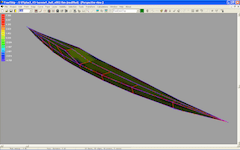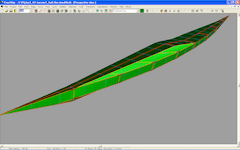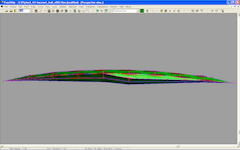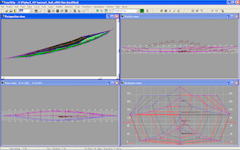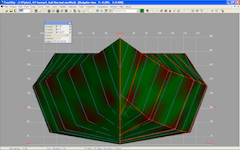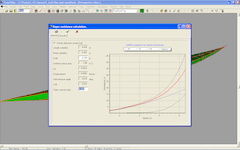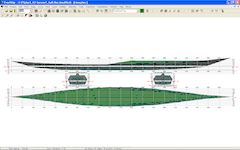 t tooks just a few hours to learn the new software and construct the basic 3D objects: hull & deck. The time – consuming tasks are adjusting the shapes and playing around with hydrostatics. Some basic measures: LOA / LWL (length overall / waterline): 5.50 / 4.44 m, BOA / BWL (beam overall / waterline): 0.483 / 0.451 m, Draft: 0.1 m, S (wetted surface area): 1.66 m2, Cp (prismatic coefficient): 0.5619, LCB (longitudinal center of buoyancy): 0.5150, LCF (longitudinal center of floatation): 0.5192.
t tooks just a few hours to learn the new software and construct the basic 3D objects: hull & deck. The time – consuming tasks are adjusting the shapes and playing around with hydrostatics. Some basic measures: LOA / LWL (length overall / waterline): 5.50 / 4.44 m, BOA / BWL (beam overall / waterline): 0.483 / 0.451 m, Draft: 0.1 m, S (wetted surface area): 1.66 m2, Cp (prismatic coefficient): 0.5619, LCB (longitudinal center of buoyancy): 0.5150, LCF (longitudinal center of floatation): 0.5192.
Additional hydrostatics parameters, VCB (vertical center of buoyancy): 0.0590 m, Cb (block coefficient): 0.4684, Cm (midship coefficient): 0.8336, Cw (water plane coefficient): 0.6385, Displacement: 0.096 tonne… Well, I wouldn’t pretend that I fully understand those parameters above, cause they contain insights into a boat that can only be correctly interpreted by an experienced designer. However, I’m tweaking around to optimize the parameters toward a higher Cp, higher LWL, and lower S.
Drag (resistance) predicted by the KAPER algorithm looks fine till now, however, the displacement is sacrificed already, 96 kg, barely enough for me (65 kg) plus 30 kg of gears. This gonna be a demanding boat with low primary stability, not recommended for beginner. It takes some real world experiences to understand why low initial stability is indeed a good thing, and why a kayak which appears to be very stable on flat water could probably throw you up side down in bumpy conditions.
Serene – 1 p1
Serene – 1 p2
Serene – 1 p3
Serene – 1 p4
Some rough calculations on the energy required to propel a kayak. My target speed is 7 kmph, or 3.8 knots. From the numbers recorded by my Garmin over the years, in normal big rivers and sea conditions, speed is reduced by 1/3 compared to the ideal condition of flat water.
That is you have to struggle at 5 knots to assure that 3.8 knots. The Kaper algorithm tells you that, this Serene – 1 hull produces a resistance force of 27.35 Newton at 5 knots (or 2.57 meters per second). Making the multiply: 2.57 x 27.35, that’s the output required: 70.39 Watt!

